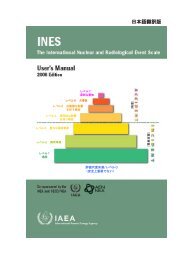Guidelines for Iodine Prophylaxis following Nuclear Accidents
Iodine_Prophylaxis_guide
Iodine_Prophylaxis_guide
Create successful ePaper yourself
Turn your PDF publications into a flip-book with our unique Google optimized e-Paper software.
<strong>Guidelines</strong> <strong>for</strong> iodine prophylaxis <strong>following</strong> nuclear accidents1999 updateand evacuation, which can reduce both the external and internalradiation exposure of the population, food and agriculturalcountermeasures to restrict ingestion of radioactive material, as well asstable iodine prophylaxis.Isotopes of iodine ( 131 I, 132 I, including that arising from the decay oftellurium-132 ( 132 Te), 133 I; see Annex 1 <strong>for</strong> table of half-lives) arelikely to be important components of the release from a severeaccident. Radioactive iodines can give rise to both external exposureand internal exposure (from inhalation and ingestion). Stable iodineprophylaxis is a protective action <strong>for</strong> which preparednessarrangements can be made as part of the overall emergency responseplan, and that can protect specifically against internal exposure frominhalation and ingestion of radioiodines.It should be noted that the term “iodine prophylaxis” refers to theblocking of the uptake of radioiodine after nuclear accidents and notto the correction of dietary iodine deficiency.The decision to plan <strong>for</strong> short-term prophylaxis against radioactiveiodine should not be influenced by dietary iodine status. Dietaryiodine deficiency increases the uptake of radioactive iodine in thethyroid. However, a normal iodine status would not reduce the need<strong>for</strong> prompt stable iodine prophylaxis in the event of a nuclearemergency. While dietary iodine supplementation in iodine-deficientareas is important in its own right, it does not eliminate the need toplan <strong>for</strong> stable iodine prophylaxis.2. Radiation risk from radioactive iodine2.1 Exposure to radioactive iodineThe radioactive isotopes of iodine, along with other radionuclides,give rise to external radiation exposure from radioactive materialpresent in a radioactive cloud, deposited on the ground and on skinand clothing. In the case of the radioactive isotopes of iodine, a majorconcern is the internal radiation exposure <strong>following</strong> incorporation anduptake in the thyroid. This will occur through inhalation ofcontaminated air and ingestion of contaminated food and drink.2






